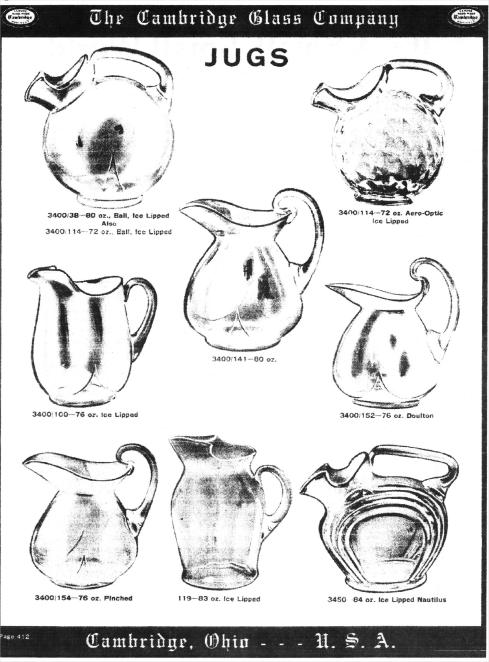Cambridge Confusion
by Mark A. Nye
Issue 310 - February 1999
This month's column is the result of a couple of letters received and answered during the past year. The questions posed by the writers have probably arisen in the minds of others and the answers should receive a wider distribution.
One writer, a recant purchaser of the Rose Point book, asked about the two different pitchers (jugs) shown in the book, both with the designation 3400/141. This particular jug is shown on pages 57, 61 and 83 in the Rose Point book. Pages 57 and 61 are reprints of two pages from the January 1940 Cambridge catalog while page 83 is a reprint of a supplemental page to the 1940 catalog, issued in late 1949 or early 1950. Only pages 57, page 573 in the 1940 catalog, and 83, 50-D in the 1949-53 catalog, are reprinted here in their original form. [NOTE: web site differs from original article, as we only show one catalog page (below) which illustrates the "Doulton" jug and the others discussed in the article.]
The 3400 line first appeared in 1930 and remained a mainstay of the Cambridge line until late in the 1940s, post World War II. It was an extensive line that included a number of jugs, one of which was designated 3400/141, 80 ounce. Exactly when this jug was introduced is not known. The first illustrations appear on catalog pages issued circa 1935-36 where it is listed as being available in Crystal, Amber, Dianthus Pink, Forest Green. Royal Blue, Amethyst, and Carmen. The identical jug with the caption 3400/141 80 ounce also appears on a catalog page issued in the late 1930s and again in the 1940 catalog.
The war years took a toll on Cambridge as well as other domestic glassmakers. Many lines were dropped or temporarily discontinued until raw materials and labor once again became available. Little specific information regarding what was being made during the middle 1940s and the first postwar years has survived. As the country returned to a peacetime mode, imports from a recovering Europe began to make inroads into the U.S. market. In addition, lifestyles were changing. To meet all these changes, Cambridge developed new lines, dropped old ones and revised some existing ones, all in the interest of meeting the changing market demands and to reduce costs. (The making of fine glass is very labor intensive.)
Making pieces easier to make was no doubt a goal of Cambridge management. Less labor meant less cost and a simpler to make piece usually resulted in less scrap and a reduction in losses. One of the pieces involved in this process was the 3400/141 jug. The handle was changed and the top finish was revised to a simpler shape. However, the catalog number was not changed and the restyled jug remained the 3400/141 80 ounce. Not a problem then but confusing today. One possible solution for today's collectors would be to designate the original version as 3400/141 (early) and the revised as 3400/141 (late) or as original and revised.
Other examples of two different pieces having the same name or item number abound and a future article will discuss more of these.
The second question involved Doulton jugs and I will begin by saying that early on I adopted the policy I would only use descriptions, line names, piece names. etc., used by Cambridge and that I could document by means of actual Cambridge documents, catalogs, price lists, advertisements. etc. This policy has been used in all my articles and the several books I have either written or edited.
In just two instances in the reprinted Cambridge catalogs do you find a jug captioned "Doulton." One such designation occurs in the Caprice line where the 178 jug is captioned in the 1940 catalog as "178 90 ounce Doulton" and the second is in the jug section of the same catalog (page 4l2, reprinted here) where the 3400/152 76 ounce jug is also described as "Doulton." In that portion of the 1940 catalog devoted to showing the 3400 line, even though the 3400/152 jug is shown, the descriptive term, "Doulton" is not used. Nor does it appear in the etchings section where the jug once again appears.
Prior to 1940, Cambridge catalog pages issued circa 1935-36 and again around 1938-39 also include "Doulton" in the caption beneath illustrations of the 3400/152 76 ounce jug. None of the other 3400 line jugs including the 3400/141, even though similar in appearance to the 3400/152, were captioned "Doulton."
The 3400/152 jug and the 3400/141 jug were made using the same mold. The lip and top shape of each was hand formed, as was the handle, and then applied while hot to the jug. This hand finishing process reduced the stated capacity of the 3400/152 jug to 76 ounces versus the listed 80 ounce capacity of the 3400/141 jug. Since both jugs underwent extensive hand finishing, the differences between the two may have, at times, become a little blurred.
What is a Cambridge 3400 line Doulton jug? Based on existing Cambridge documentation, catalogs and price lists, the only 3400 line jug that should be designated Doulton is the 3400/152. Others, such as the 3400/141 and perhaps the 3400/154 (a pinched version of 3400/141) could be referred to informally as Doulton style. Careful examination of the 1940 catalog page reprinted with this article will reveal the differences between the true Doulton jug, the 3400/152, and the other jugs in the 3400 line.
| The only jug labeled "Doulton" is the second one down on the right side. |
|---|
 |
